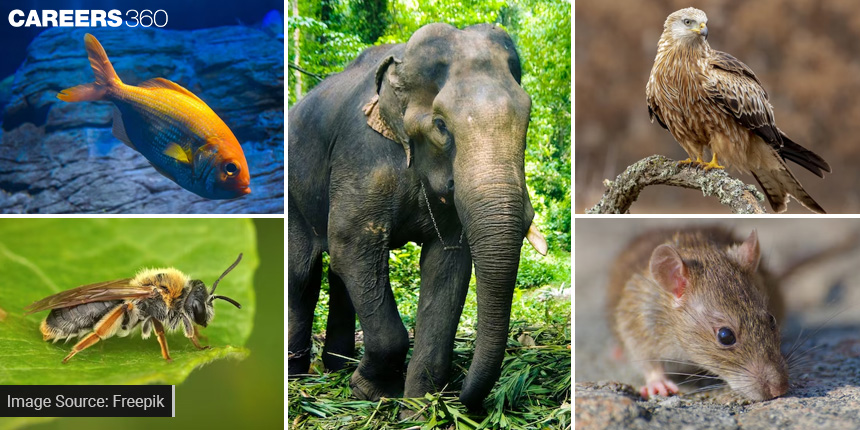Osmoregulation In Terrestrial Animals: How Does Water Excretion In Animals Occur?
Excretion is the physiological process that eliminates waste from the body of an organism. All organisms undergo various physiological mechanisms to process food molecules and produce energy from them for the functioning of the biological system. Digestion is the first physiological process, followed by assimilation and absorption, and finally excretion.
This Story also Contains
- Terrestrial Animals
- What Is Perspiration, And Do Animals Sweat?
- Other Ways Of Water Excretion In Terrestrial Animals
- Why Do Terrestrial Animals Conserve Water?

When the food products are metabolised in various cycles, they generate some waste products along with major products as well. This metabolic waste has to be eliminated regularly from the body; otherwise, it can cause problems.
The main mode of excretion is via urine and stools; however, excretion also depends on the type of metabolic waste. For example, carbon dioxide is a metabolic waste generated from respiration and is eliminated from the lungs, whereas the skin removes certain wastes in the form of sweat.
Like humans, animals also excrete waste in many ways. Let us study them in the following sections.
Also Read | How Does Early Onset Of Puberty Affect Individuals Over Time?
Terrestrial Animals
Due to the diversity of animals on the planet, they have been divided into a number of groups based on habitat and other traits. The animals living on the land are known as terrestrial animals, and they belong to the vertebrae category. This means they have a spine and include many pets as well as wild animals. Tiny animals like rats or huge ones like elephants are all terrestrial animals. Some birds, like hawks and eagles, are arboreal but are also considered terrestrial animals.
Apart from these, many insects, marsupials, and reptiles are also terrestrial animals, as the majority of their lives are spent on land.
What Is Perspiration, And Do Animals Sweat?
Thermoregulation is a process in organisms that occurs to maintain the core temperature. If the core temperature rises, then the body triggers sweating to lower the body temperature. The water or fluid collected on the skin's surface moistens it and cools the body as it evaporates. This water vapour takes away the heat as it rises; therefore, sweating cools down the body. Sweat also contains wastes such as urea, water, and salts, thus helping in excretion.
On the other hand, if the body is cold or the temperature is low, then the body shivers so as to produce heat and keep the body warm. So, you see, sweating is important for thermoregulation.
Humans have a unique way of sweating as they have sweat glands that all terrestrial animals do not possess, and hence, they do not exhibit sweating. However, some animals (non-furry ones) like hippopotamuses, monkeys, and horses do sweat. Dogs and cats also sweat from their paws; however, like most other terrestrial animals, these animals pant to cool off their bodies.
Also Read | Maternal Behaviour: How Do Animals Nurture Their Young Ones?
Fun Facts
Horse sweat contains latherin, which acts as a natural detergent and hence can function as soap.
The hippos secrete some antibacterial pigments in their sweat, which is pink-coloured.
Other Ways Of Water Excretion In Terrestrial Animals
The integuments and the respiratory organs help in excretion of water from the body's surface. The former includes the outer protective layer or skin, and the latter includes the nose, nasal passage, mouth, and more.
Terrestrial animals mainly lose water to the environment through evaporation. One of the ways is sweating, which occurs in only some animals. Another method of water evaporation is panting, through which several mammals, birds, and reptiles lose huge amounts of water in the form of water vapour.
While panting, the internal structures lose water in the form of water vapour that is expelled as hot air from the mouth or nasal passage of the animal. In exchange, the animal breathes in cool air to lower its overall body temperature.
Why Do Terrestrial Animals Conserve Water?
Since land animals lose a large amount of water through evaporation, they need to retain water. They also do not have readily available options all the time to drink water and balance the body's water requirements. Due to this, they excrete hypertonic urine, which means their urine is toxic and has high amounts of nitrogenous waste and lesser amounts of water.
Almost all animals have mechanisms that help them balance the physiology of their bodies. For example, butterflies can get hot due to constant flying, which requires continuous exertion of the flight muscles. To avoid excessive heat and consequent water loss, butterflies stop flying.
Similarly, lizards and other reptiles have thick, scaly skin that enables them to conserve water.
Some desert-dwelling and other terrestrial animals trick the brain to cool off and retain water by opening their mouths. Through this, the wet mouth membranes evaporate water and give off a cooling sensation, thereby signalling the brain to cool down as well.
Water is an essential molecule that is consumed via drinking, through some foods, or produced inside the body metabolically. As important as it is to drink water regularly and regulate the water concentration in our bodies, it is also necessary that it be eliminated regularly.
Also, Read | Amazing Facts About Eating Habits And Weird Food Habits Of Some Animals
Applications for Admissions are open.
As per latest syllabus. Physics formulas, equations, & laws of class 11 & 12th chapters
JEE Main Important Chemistry formulas
Get nowAs per latest syllabus. Chemistry formulas, equations, & laws of class 11 & 12th chapters
JEE Main high scoring chapters and topics
Get nowAs per latest 2024 syllabus. Study 40% syllabus and score upto 100% marks in JEE
JEE Main Important Mathematics Formulas
Get nowAs per latest syllabus. Maths formulas, equations, & theorems of class 11 & 12th chapters
